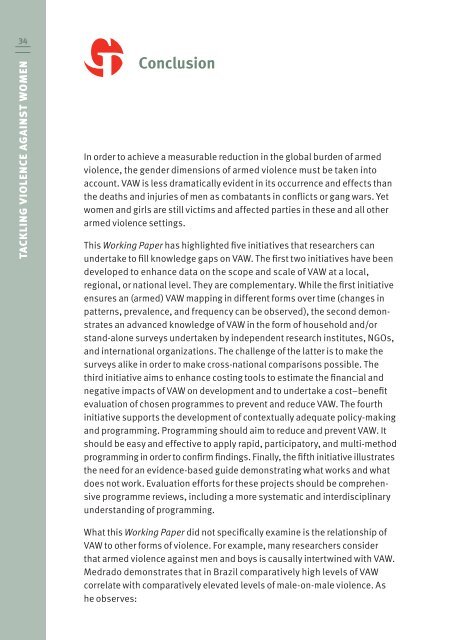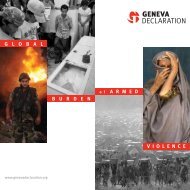Tackling Violence against Women: From Knowledge to Practical
Tackling Violence against Women: From Knowledge to Practical
Tackling Violence against Women: From Knowledge to Practical
Create successful ePaper yourself
Turn your PDF publications into a flip-book with our unique Google optimized e-Paper software.
34<br />
TAckliNG ViolENcE AGAiNsT WomEN<br />
conclusion<br />
In order <strong>to</strong> achieve a measurable reduction in the global burden of armed<br />
violence, the gender dimensions of armed violence must be taken in<strong>to</strong><br />
account. VAw is less dramatically evident in its occurrence and effects than<br />
the deaths and injuries of men as combatants in conflicts or gang wars. Yet<br />
women and girls are still victims and affected parties in these and all other<br />
armed violence settings.<br />
This Working Paper has highlighted five initiatives that researchers can<br />
undertake <strong>to</strong> fill knowledge gaps on VAw. The first two initiatives have been<br />
developed <strong>to</strong> enhance data on the scope and scale of VAw at a local,<br />
regional, or national level. They are complementary. while the first initiative<br />
ensures an (armed) VAw mapping in different forms over time (changes in<br />
patterns, prevalence, and frequency can be observed), the second demonstrates<br />
an advanced knowledge of VAw in the form of household and/or<br />
stand-alone surveys undertaken by independent research institutes, NgOs,<br />
and international organizations. The challenge of the latter is <strong>to</strong> make the<br />
surveys alike in order <strong>to</strong> make cross-national comparisons possible. The<br />
third initiative aims <strong>to</strong> enhance costing <strong>to</strong>ols <strong>to</strong> estimate the financial and<br />
negative impacts of VAw on development and <strong>to</strong> undertake a cost–benefit<br />
evaluation of chosen programmes <strong>to</strong> prevent and reduce VAw. The fourth<br />
initiative supports the development of contextually adequate policy-making<br />
and programming. programming should aim <strong>to</strong> reduce and prevent VAw. It<br />
should be easy and effective <strong>to</strong> apply rapid, participa<strong>to</strong>ry, and multi-method<br />
programming in order <strong>to</strong> confirm findings. Finally, the fifth initiative illustrates<br />
the need for an evidence-based guide demonstrating what works and what<br />
does not work. Evaluation efforts for these projects should be comprehensive<br />
programme reviews, including a more systematic and interdisciplinary<br />
understanding of programming.<br />
what this Working Paper did not specifically examine is the relationship of<br />
VAw <strong>to</strong> other forms of violence. For example, many researchers consider<br />
that armed violence <strong>against</strong> men and boys is causally intertwined with VAw.<br />
Medrado demonstrates that in Brazil comparatively high levels of VAw<br />
correlate with comparatively elevated levels of male-on-male violence. As<br />
he observes:









